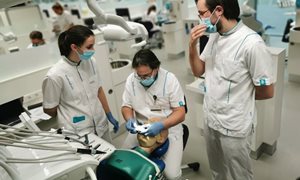
Teeth grinding and molars on top of each other: stress from corona causes an increase in dental damage. That's what they noticed at the department of dentistry at Radboudumc.
Broken pieces of tooth enamel, wear and tear on the teeth and spontaneously cracked molars, every dentist has to deal with them in the treatment room these days. Even overloading of the jaw muscles is more common during this coronary period, says Simone Gouw, orofacial physiotherapist and involved in the department of dentistry at Radboudumc. According to her, the increased coronal stress has a lot of influence on the teeth and bruxism, as teeth grinding is officially called, is often dealt with too simplistically.
Bas Loomans, a dentist specializing in dental wear, recognizes the problem: "There hasn't been any specific research into it. I do think that corona and everything that comes with it - sitting at home a lot, not being able to meet people, not being able to go to work - creates a lot of stress. And tension and stress is a major factor in grinding and clenching. So is it a real thing that it's increasing? Yes!"
Grinding and clenching
"Our language says it all," Gouw states, "Stress causes people to put their molars together, grind their teeth and get the clench in their jaws. That results in damage." Loomans further explains the problem: "Grinding is the movement, the noise kicking, the sliding of teeth over each other. That produces these wear patterns like you have a cow where everything is worn down." Clenching, he says, is more static. "That's putting your teeth together. And that produces more localized damage. It can end up causing more wear and tear, so that tooth loss occurs. There are such high forces coming on those teeth. As much as forty times more than eating a carrot. And then the weaker parts are going to break one day."
Stop chewing gum
According to Gouw and Loomans, the road to a solution begins with awareness. For the gritter who only grinds at night and for whom it does not lead to much damage, but especially the partner experiences the most inconvenience, a grinding plate can offer a solution, according to Loomans. Gouw also has a few tips for reducing coronary stress: "Stop chewing gum to relieve the jaw muscles. And do relaxation exercises."
See also the article of Omroep Gelderland (in Dutch) and watch the YouTube video here.
Source: Omroep Gelderland
Related news items

Bas Loomans appointed professor 'Oral Function and Restorative Dentistry'
10 January 2022 Bas Loomans has been appointed professor 'Oral Function and Restorative Dentistry' at the Radboud university medical center / Radboud University as of 1 December 2021. go to page
Clinic for tooth wear interaction education, research and patient care
9 March 2020 No extravagance entrance, no screaming advertisements, … but nevertheless a couple of proud colleagues. Hanneke Huijs-Visser and Bas Loomans are the initiators of this clinic. go to page
Bas Loomans received Mid-Career Award
18 July 2019 Bas Loomans received in Vancouver the STEPHEN BAYNE MID-CAREER AWARD of the International Association for Dental Research (IADR) go to page
H2020 Grant for Frank Walboomers and Ronald Bartels
23 May 2019 Frank Walboomers and Ronald Bartels, theme Reconstructive and regenerative medicine, have received a € 500,000 grant for research into graphene biomaterials from the Europan Union Horizon 2020 FET Open programme. go to page
€ 100k grant to investigate relation between bruxism and tooth wear
13 November 2018 The research proposal 'Bruxism and tooth wear: a destructive combination?' of Bas Loomans and Stanimira Kalaykova has received a research grant of € 100k on the occasion of the 125th anniversary of the ‘Nederlands Tijdschrift voor Tandheelkunde (NTvT)’ go to page
